FastTrack Training. "Network Basics". "The structure of routers, routing platforms from Cisco." Eddie Martin December 2012
About a year ago, I noticed an interesting and fascinating series of lectures by Eddie Martin, which, thanks to its history and real-life examples, as well as its tremendous learning experience, is amazingly comprehensible and allows you to gain an understanding of quite complex technologies.
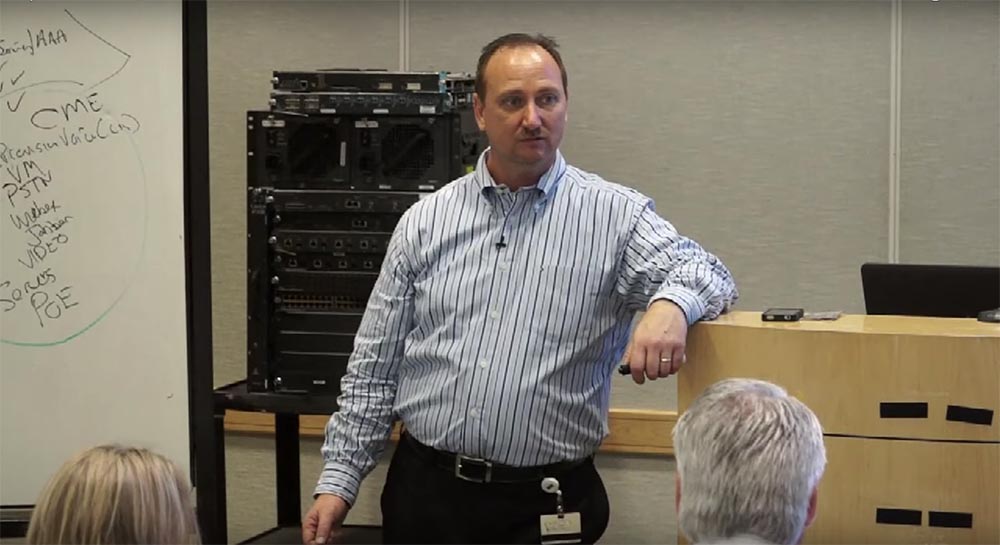
We continue the cycle of 27 articles based on his lectures:
')
01/02: “Understanding the OSI Model” Part 1 / Part 2
03: "Understanding the Cisco Architecture"
04/05: “The Basics of Switching or Switches” Part 1 / Part 2
06: "Switches from Cisco"
07: "Area of use of network switches, the value of Cisco switches"
08/09: "Basics of a Wireless LAN" Part 1 / Part 2
10: "Products in the field of wireless LAN"
11: The Value of Cisco Wireless LANs
12: Routing Basics
13: "The structure of routers, routing platforms from Cisco"
14: The Value of Cisco Routers
15/16: “The Basics of Data Centers” Part 1 / Part 2
17: "Equipment for data centers"
18: "The Value of Cisco in Data Centers"
19/20/21: "The Basics of Telephony" Part 1 / Part 2 / Part 3
22: "Cisco Collaboration Software"
23: The Value of Collaboration Products from Cisco
24: "The Basics of Security"
25: "Cisco Security Software"
26: "The Value of Cisco Security Products"
27: "Understanding Cisco Architectural Games (Review)"
And here is the thirteenth of them.
Today we will have role-playing games. You will play the role of an IT expert, and I will play the role of a dumb client. So let me tell you about my problem.
I have a headquarters. And I do not understand anything except my business. I made millions of dollars on it, my family has been involved in this business for decades, and so on and so forth. But now I want to expand my business. I have a main office and a small data center in it, but I want to be closer to my customers and I plan to open 5 more new offices within six months, 5 out of a dozen offices, which I am planning to open within 18 months. And if I do not make at least five now - my competitors will eat me.
So, I know that I will have to get everything that is needed to build a WAN. I know that you guys are experts at Cisco and you know everything about networks, you have this little badge that tells me that I have to ask you, what are the requirements for separation?
I spent a lot of countless years and money to provide these people at headquarters with technologies that are very productive, but what technologies should I use in the offices in order to make the staff in the offices as effective as in the head office ? Because I have never done this. I will have 25-30 employees in each of the branches. What are my apps? Yes, whatever, we use a variety of software, computers, tablets.

So what do we need? Did you say: "WAN router accelerator"? Ok, let's draw a router here and sign it with the WAN Accelerator. Then you tell me what this thing is, it sounds cool, but it certainly costs a lot of money!
We must discuss your needs at the beginning. If your employees need to be as efficient as the head office employees, you should be able to use the same applications. Same applications as headquarters. Am I supposed to create a second data center? Of course not. What do we need then? That's right, communication to transfer our applications and information back and forth. What else? Wireless connection? Do you mean access points? Yes, in new offices we need access points, but let's name everything that is needed to create a working network, in one word - WLAN. Next, we need security, otherwise customers will not want to deal with us. I will “hook” to security the necessary services of identification, encryption, and so on.
Let's add another IPS, IP telephony service. In order for an employee to work from home, for example, during a snow storm, when it is impossible to get to work, we need to add a VPN service to the branch office. And, of course, employees will work with the Internet, so we need a firewall.
We will also need equipment for voice communications, that is, telephones. If I have a phone, it means that I have VM functions - voice messages. And I should be able to make an external call, that is, I need to connect to the PSTN public telephone network. We will also need WebEX for video conferencing and the Jabber instant messaging protocol. Let's add here the same video.
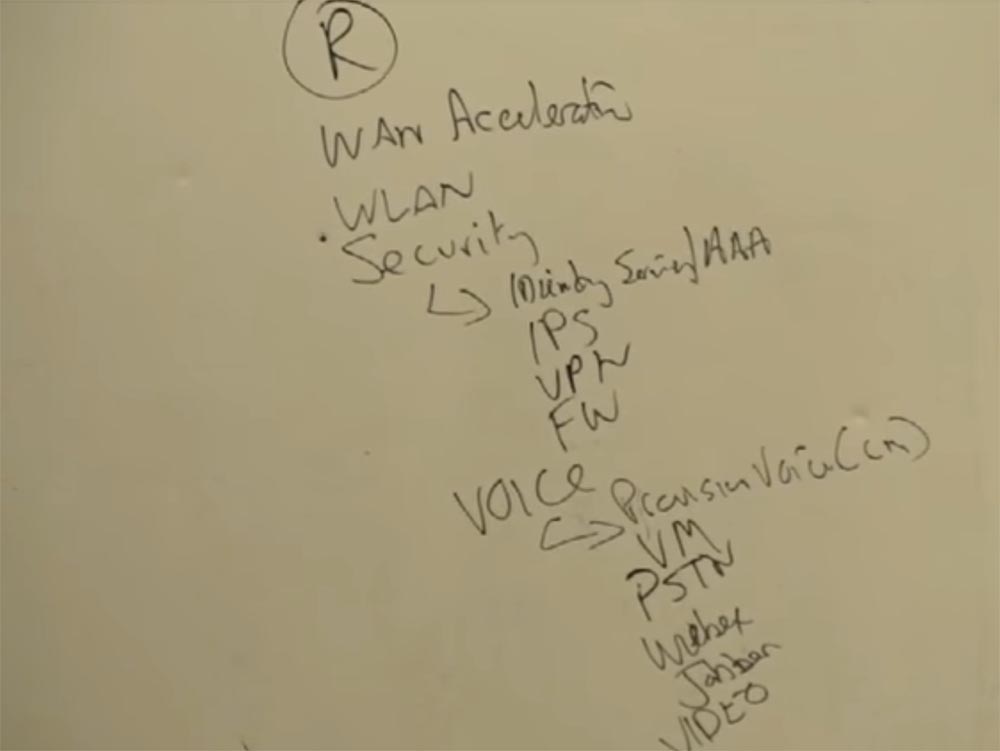
Since I am in sales, I’ll also place a server here and add PoE.
Do you know what we just did? We identified the IT resources that should be handled by the router. And, here's another thing we missed - you need to put another switch here, next to the router. Now we have to stuff all these resources into one box so that they work at the same time. And this box is our integrated services router - ISR G2 Router (Integrated Services Router Generation 2). He does everything we just talked about.
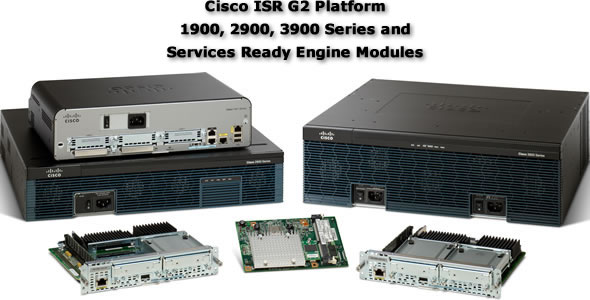
Inside it are the most innovative Cisco technology. Inside this box is the motherboard on which the multicore processor is located. It works on the basis of our iOS. In the chips of each ISR, we lay down the VPN and FW (Fire Wall) capabilities, at the hardware level, we also place them on the motherboard. You told the ASA (Adaptive Security Appliance or Adaptive Security Device), yes, this is the same chip as the ASA provides the firewall. Why is this enterprise class device? Because all this is scaled for 200 people. You can buy a big box and put more chips in it. Thus, the largest ASA can handle up to 20 Gbps of traffic and protect it with a firewall. And some large customers need it. This same device, capable of handling 185 Mbps, is ideal for branch offices.
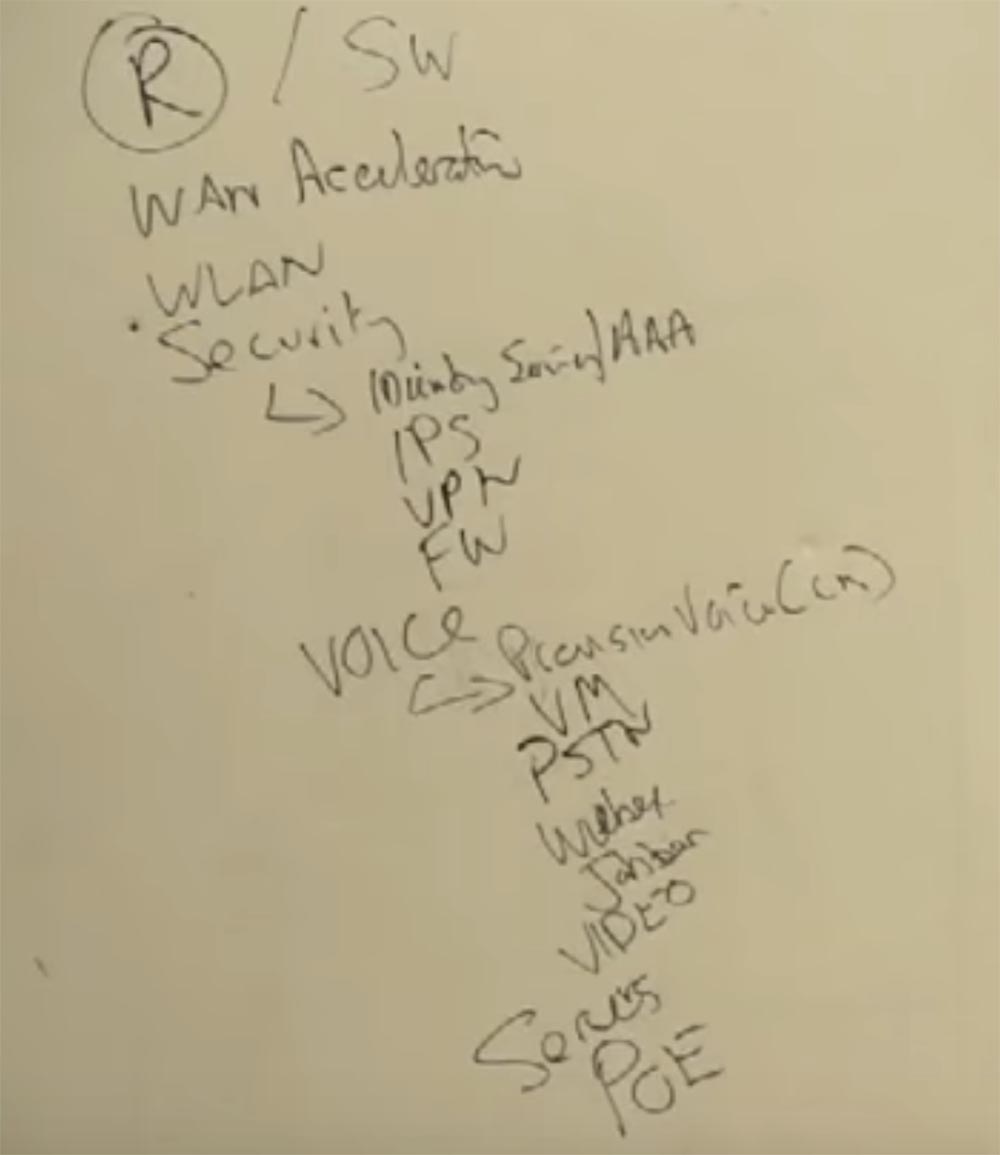
As for WAN acceleration, this is possible thanks to our iOS, which you can install on your device and try it out for 30 days for free, or you can add a separate server to this device, which will provide great opportunities. Now I will show you such a "box", they come in different sizes.
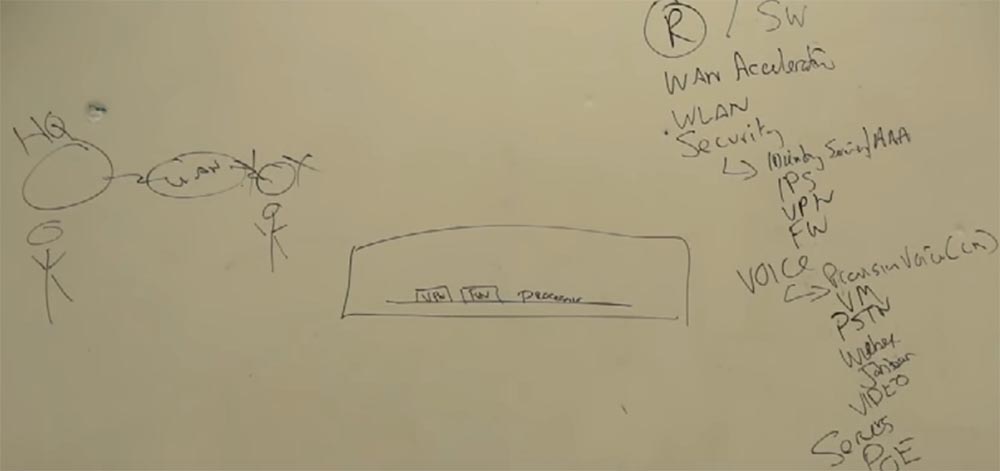
This is a modular design, it has several slots that connect the modules to the motherboard.
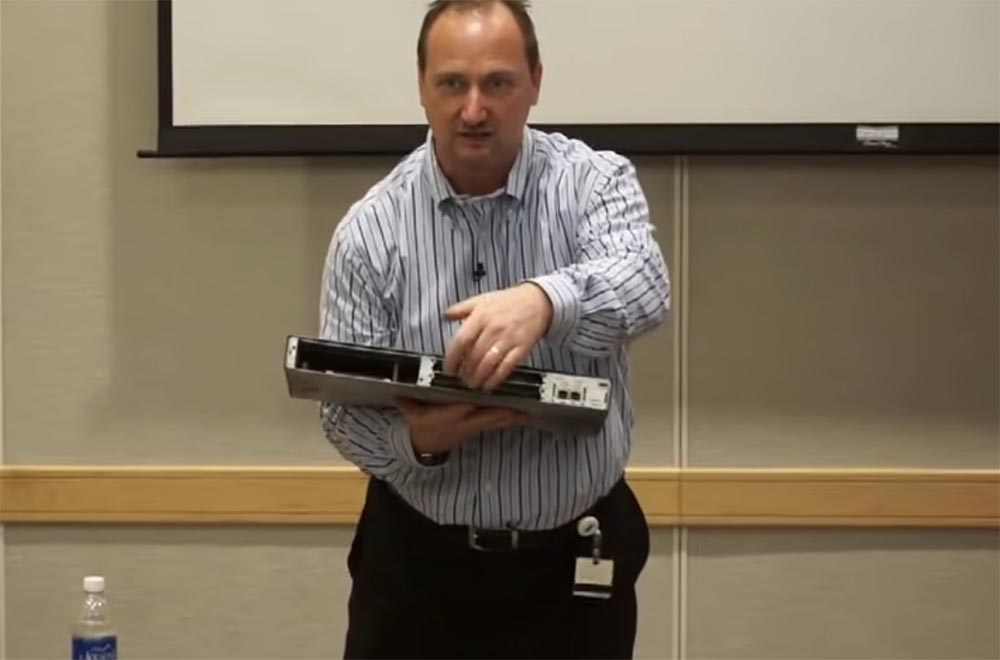
A large slot is designed for the server, smaller - for expansion cards. The router can have a larger size, now I will show you a big “box”.
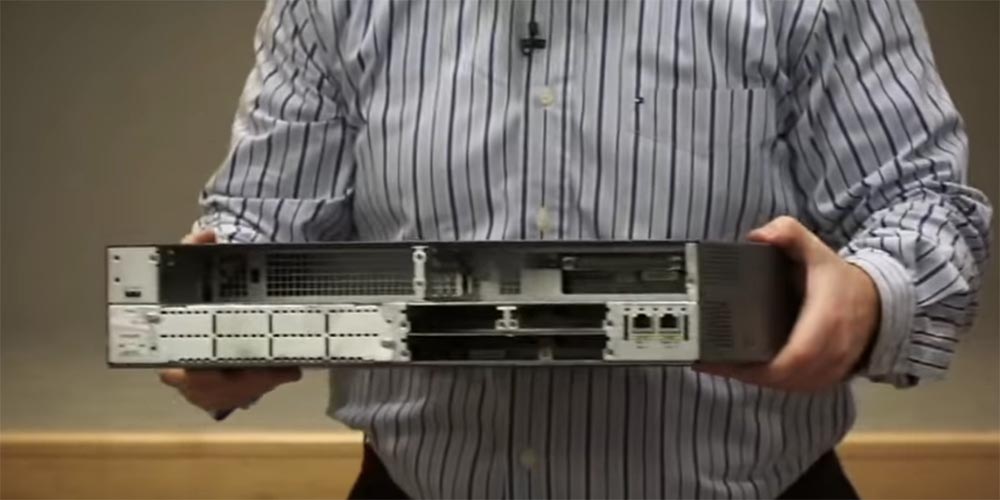
Thus, choosing the appropriate size of the case, you can place everything you need in it and insert everything you want. What needs to be done to enhance the safety effect? Provide our data with IPS, VPN and FW technologies. All this is bought and activated under license. It is all inside at the beginning, and if you need these functions, you buy a license key and turn them on. You activate data encryption via VPN when you use MPLS, start your firewall, use IPS technology. Now you can put your authentication server (AAA server) here if you need a WLAN, along with a WLAN controller. We call this solution ESP — a deployable service platform.
The WLAN controller has a smaller processor on this daughter card and therefore can support up to 10 access points. This is what we call ISM, an integrated service module. And this amount may well be enough for my needs.
Now let's talk about the voice. Inside iOS, there is a CME - Communication Manager Express protocol. Depending on the size of the router, it can become your voice switch and provide support for up to 450 phones or video communication devices, ensure the setting and management of your calls and our recommendation here is to use the TX 200 here. And how can you install and manage it? Inside our iOS there are licenses for this.
A DSP digital signal processor is located on the motherboard. It provides voice communication and voice and video signal processing inside the router, which completely destroys the PSTN (standard telephone network). Thus, inside the router is placed all the necessary "hardware", that's what today is the hardware of our equipment. It is all united by a common motherboard. It is possible to place boards inside the router, which are intended for access to the standard telephone network, for a local network, for connecting to the Internet, placing a fax machine for working with analog phones, a slot for connecting up to 4 analog phones. We can put in the router board for medianet, video transmission support controllers (h.323 at the controller level), PoE, which will provide power through the network and will support energy saving functions (energywise).
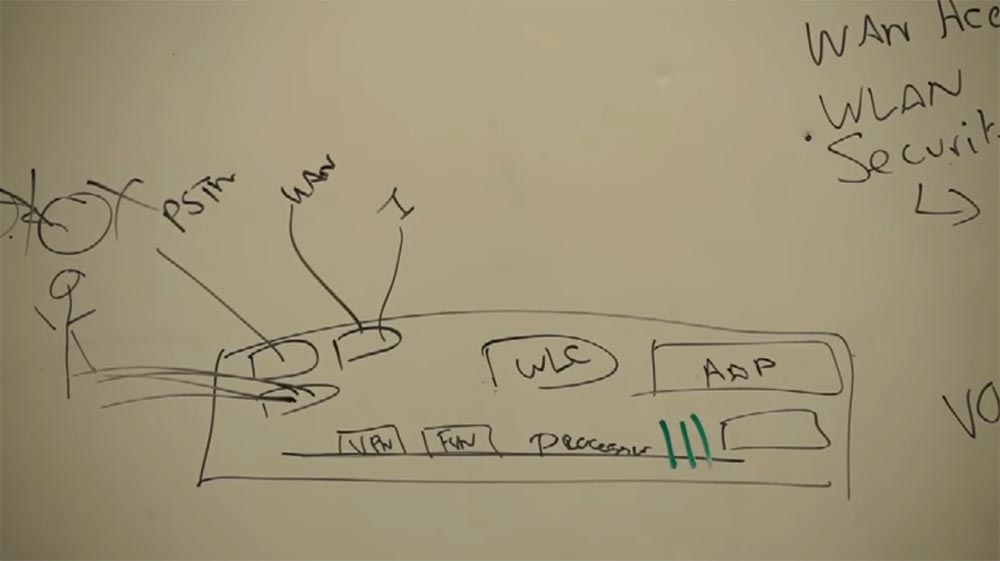
This is where the three Cisco architectures converge, this is where the endless field for collaboration is. I will circle the block of cooperation with a green marker. In the data centers, which we will talk about with you today, we use series B, series C and series E routers, which we are talking about now.
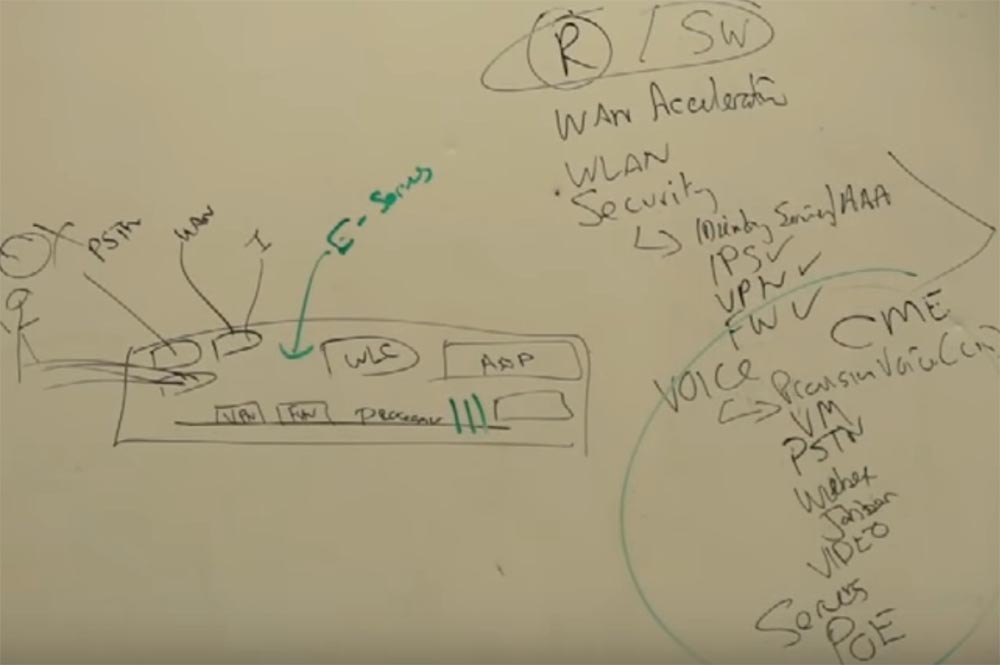
What is the difference between all this and the Business Edition 6K? Business Edition 6K is a virtual server that is equipped with all of our communication management systems and other things, and it can support up to 1000 clients. And this is a router. We will talk to you about this tomorrow.
Now let's go to the Cisco site, and I'll show you something else. Here is a page where routers for our branches are shown. These are solutions for remote offices. Here, on this page of the site, it is written: “Transform your branch management experience.”
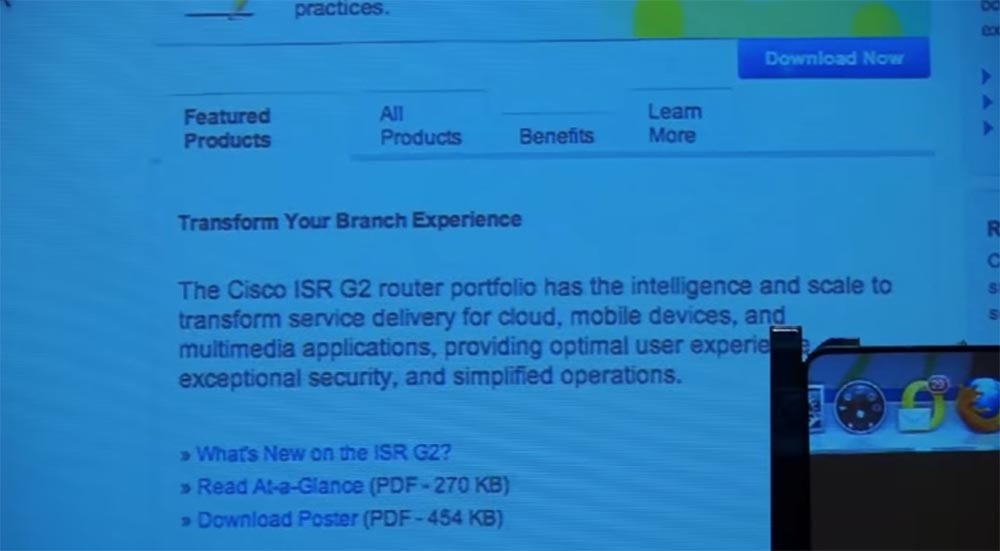
It has everything you need for building architecture. So, what routers do we use to communicate with the CVO (virtual office)? These are ISR 800 series routers. They are perfect for this task, they have built-in VPN, firewall, everything we need. This series is designed for small home offices. Routers are more serious - these are the 1900, 2900, 3900 series. Consider the 3900 ISR series router.
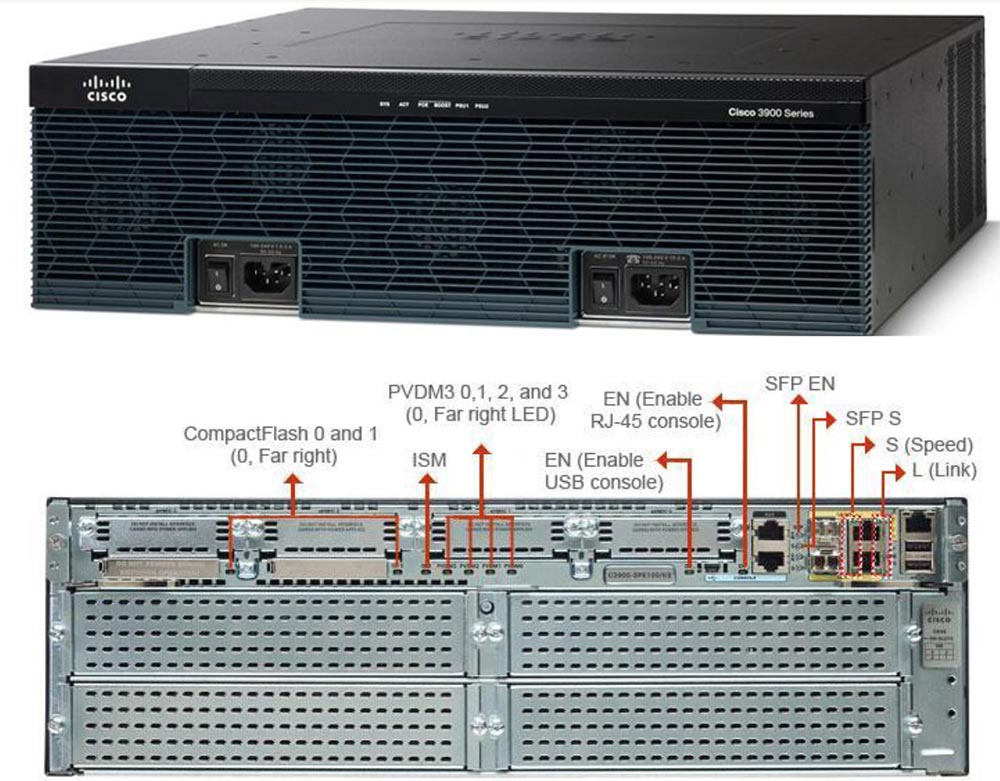
In this router, we can have more than 72 ports for connections, or if you want these ports to have PoE support — up to 48 ports, which is enough for an office with 35 employees. And it can be a level 3 switch (L3), it is actually a module for the 3560 series switch chassis. There is no supervisor board in this router, it is actually running on the processor on the iOS side, but it has a redundant power supply. It has a service module and 4 slots for interface cards.
A service module is an insertable module equipped with a multi-core processor, a hard disk with a capacity of 1 TB, 48 GB of RAM, connectors to connect to the network, and so on. In essence, this is the server that is placed here. In the E series there is support for VMWare and 4 processors are installed, also 48 GB of RAM and you have the opportunity to run many VM virtual machines to run applications. And this is cool, it gives us perhaps a slight advantage over the decisions of competitors.
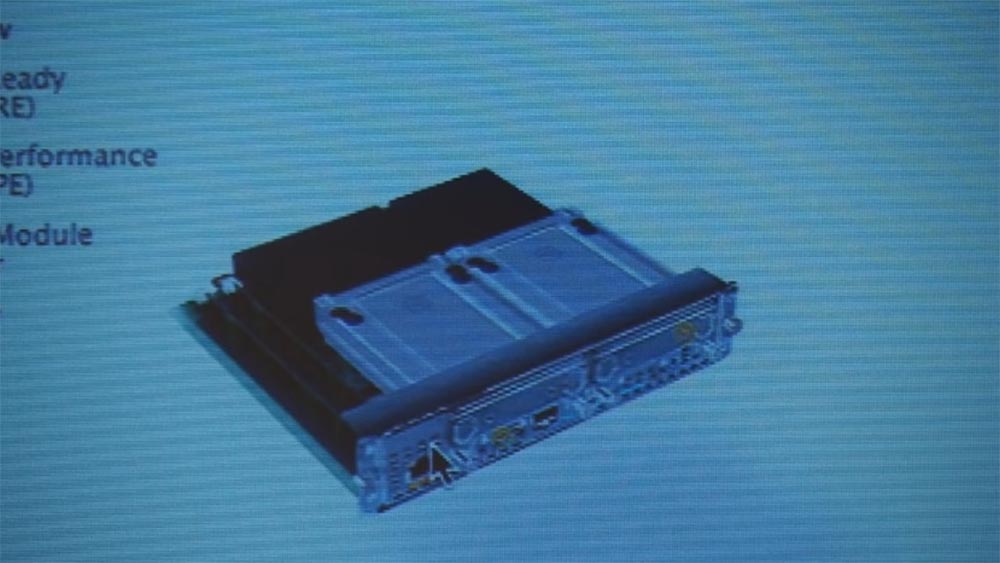
In this "box" there are a variety of things, practically everything that I may need. How many competitors offer something similar? If it were not for this solution, I would have to communicate to someone who sells a WLAN, and to another person who sells security and encryption systems, a third person who has equipment for medianet, and so on. You would need 7 different vendors that support these technologies, but when using Cisco equipment, you only apply to 1 seller. We are “number 1” in routing, switches, WLAN, virtual networks, in matters of security, in streaming video transmission, in voice telephony, in all these categories. In some categories, such as PoE, we are the only ones. That is why if you want to get the best-in-class solution - it’s better to contact us.
If you have network problems, one call corrects them all. I came across a situation when I had problems with a telephone connection, and I called one guy, he answered: “These are not my problems”! I called another, he also said that it was not his problems, and so on. And if I didn’t have a meeting with them all, they simply redirected me to each other. And here you only need one call to our support team!
Tell me, who of you knew about this? Only one or two people! So, our routers are unique, they strongly distinguish us from routers from other manufacturers, and any seller in our company should know about it. He should know that we have all 3 architectures concentrated in one box. When we sell our solutions to headquarters, they no longer cease to use it and start ordering solutions already for branches. Thanks to this, we were able to penetrate deeply into the market and occupy our own niche of network equipment. We do not stop in the development of routers, we are engaged in innovations.
I was asked a question, how does our equipment differ from Juniper J-series? Great question! By the fact that they do not transmit or process the voice, they do not. Are you saying they have VoIP? Yes there is. They connect you to a regular PSTN telephone network. Can they create a video bridge? No, they can not! If they have WLAN inside the "box" of the router? No, he's not there. They can make a WLAN, but this is not integrated into their solution at the moment. Can they provide other voice and video features? Can not. They cannot provide phones and customize them. They have neither PoE, nor routers with high density of connection ports (high-density switching). They just make routers, while Cisco makes routers with faster processing. Do they make servers or software for virtual servers? I do not think.
Their routers are probably no better than our 1998 routers when we did OverIP routing at Cisco. I had a neighbor, a very smart guy, he wrote programs, in fact the code for routers, and we worked together at Cisco. One day, at that time I had already quit Cisco, I went out into the yard for a walk and he went out, then I took 2 beers and we went out to talk. He said that they started working on a new project at Cisco, and they want to abandon the first-generation routers that knew all the things we were talking about, since Juniper launched a router with faster packet processing, J1 series, capable of processing 750,000 packets per second, while Cisco routers could provide only 500,000 pps. I said, "Really?" - "Yes, dude, we have problems." I said, "Mickey, let me tell you something." Listen, if I start selling to my customers, network providers, equipment with this stuffing, Cisco just have to cut off my fingers with a very dull knife, one at a time, since I do not deserve this product. Because in Juniper there is no support for all that is in the G1 series, they will never make it better than us in a legitimate way. ” They tried to copy some of our solutions, and put them in their equipment, but they didn’t get out of it. A lot of companies tried. Huawei - God in the IT industry, tried to make a similar copy, but even they could not beat Cisco, because customers know that they are probably not as good as they say in these decisions. And this is our main difference.
Let's continue the conversation about the capabilities of our routers that are important for the client, returning to the Cisco site. Cisco has 3 different groups of routers, we will discuss 2 groups of three. Now we will talk about the different requirements for routers for branches and routers for headquarters. The main office needs a complete solution for processing large amounts of data, and since it is large - we will not put all the possibilities in one device. For branches you need some other equipment. Consider the differences in the characteristics of the ISR G2 family of routers, what they support, what they don't support.
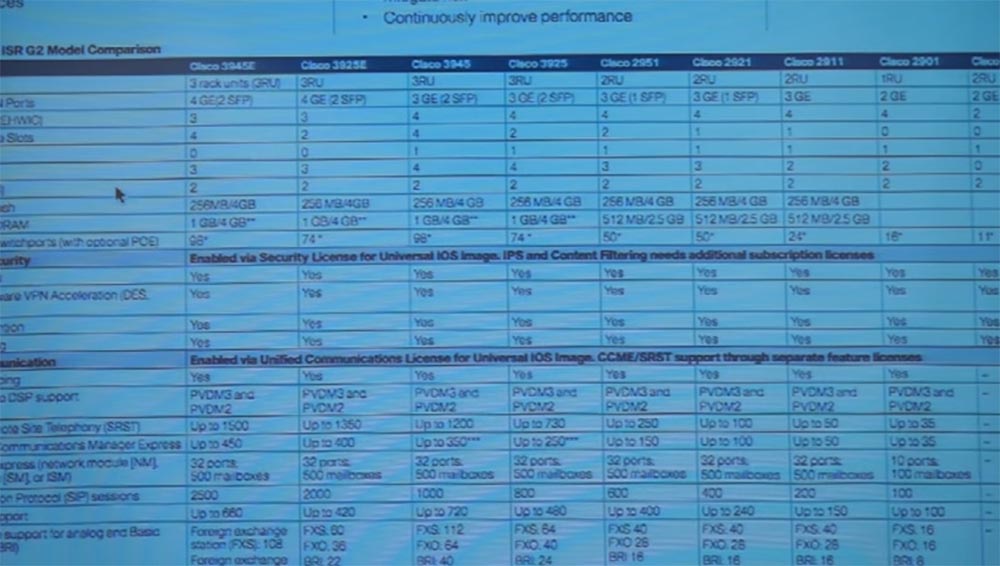
As you can see from this table, routers in this series begin with models 3540 and 3945 V and go down to models of the 1941 and even 800 series that support CVO and are necessary for organizing a virtual office at home, as we discussed with you. Depending on the qualities that we need, they have a different form factor and different possibilities. We ensure the availability of a full-fledged firewall (firewall) for the entire product line, as clients will connect to the Internet. This is built into the hardware of the product, namely the same ASIC integrated circuit used in the ASA. Moreover, we provide hardware accelerated encryption for the entire product line. There is protection from external penetration, filter counters are also available. But all these routers contain different possibilities for voice transmission, video stream support, creating video bridges, the ability to process DSPs to convert traditional telephony into IP telephony, Cisco Unified Communications Manager Express (CME) is essentially a PBX functionality, corporate telephony system. And we can support starting from 450 phones, depending on the device you choose. Untity Extress is voicemail. SIP allows you to establish SIP connections. Digital Voice support makes it possible to install up to 660 PRI T1 connections. FXS and FXO connectivity is available for all platforms. The ISR G2 series offers all of these capabilities in a single solution, allowing the customer to deploy it. In this way, we can ensure the same productivity of the branch staff that headquarters employees possess.
Let's talk about the cost of these devices, about the cost of the technologies incorporated in them. For example, the 2600 series is a multifunctional equipment. We have the first generation of this series ISR G1 2600 and the second generation ISR G2 2900. So, the base cost of the 2691 router, which I chose to buy for my “home lab” without any additional features, is $ 6495. We, as Cisco employees, had discounts on their own. But I was given a modest discount and the price of $ 4,500 only due to the fact that adding a VPN function to this router would cost another $ 1,500. This is really an expensive "box". I bought one, of course, but I had at least two. And the second wife "caught" me. And for a whole year I could not talk about the expensive women's clothing store Talbot in any bad sense.
And when the second generation of these routers arrived, it was replaced by the first one, which provided 4 times higher packet processing capacity, ISR G2 2900 router, with all the necessary lotions and built-in functions (VPN, firewall, etc.) buy them separately for $ 1500 each), do you know how much it cost? Only $ 3895, that is twice cheaper! And now, when this generation of routers is leaving, and the new provides 2-3 times more features, they cost the same money. I have already told you about this trend. The more technology inside, the cheaper they cost the client. What happens to the prices of our products? They are constantly decreasing as demand grows and technologies develop. And that is why I consider renting such equipment as more profitable for our clients.
I note that 80% of our clients work not in headquarters, but in branches. . ISR G2, .
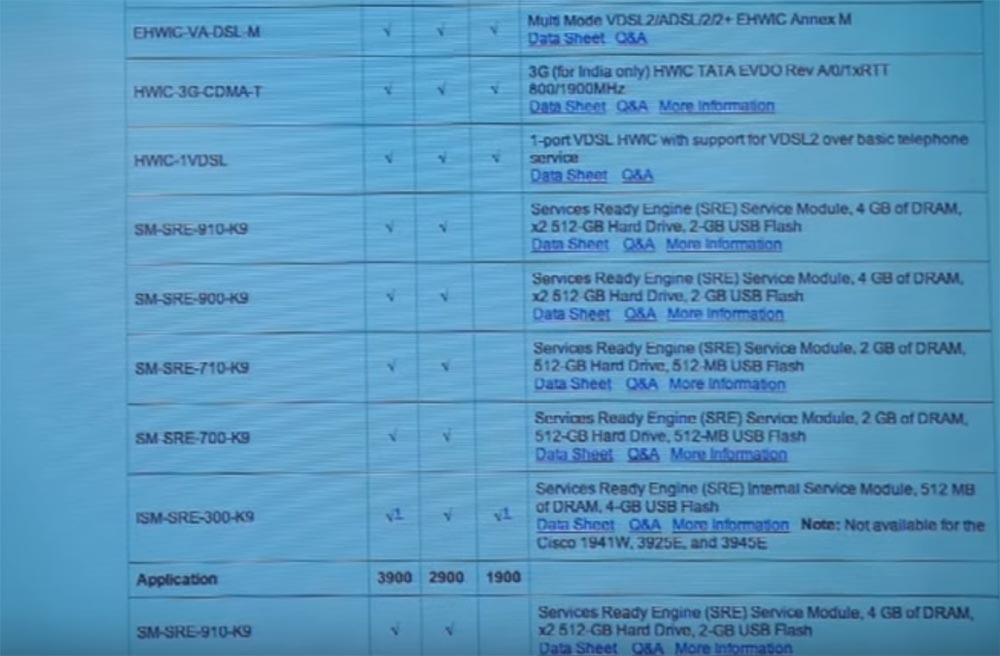
. , , , ISR G2. , HWIC CDMA, VDSL , , SRE — Service Rating Engine , . , 72 FXS , . . , Walmart? ISR G2, , , .
, ASR, Aggregation Services Routers, , , , -. -, -, . . ASR 1000. 6 .
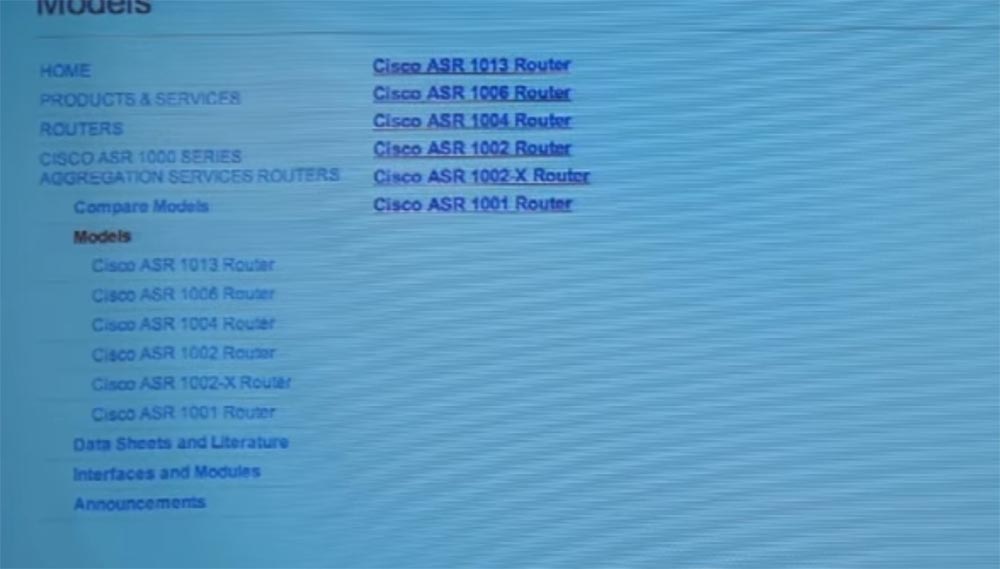
- SDN, , , . - .
Cisco ASR . . QuantumFlow Processor. , , ASR 1000. Cisco , . 40 , ASR . ASR 1000, 5000, 9000 – QuantumFlow. 40 , 4 , 160 . Cisco 5 , (R&D), -, .
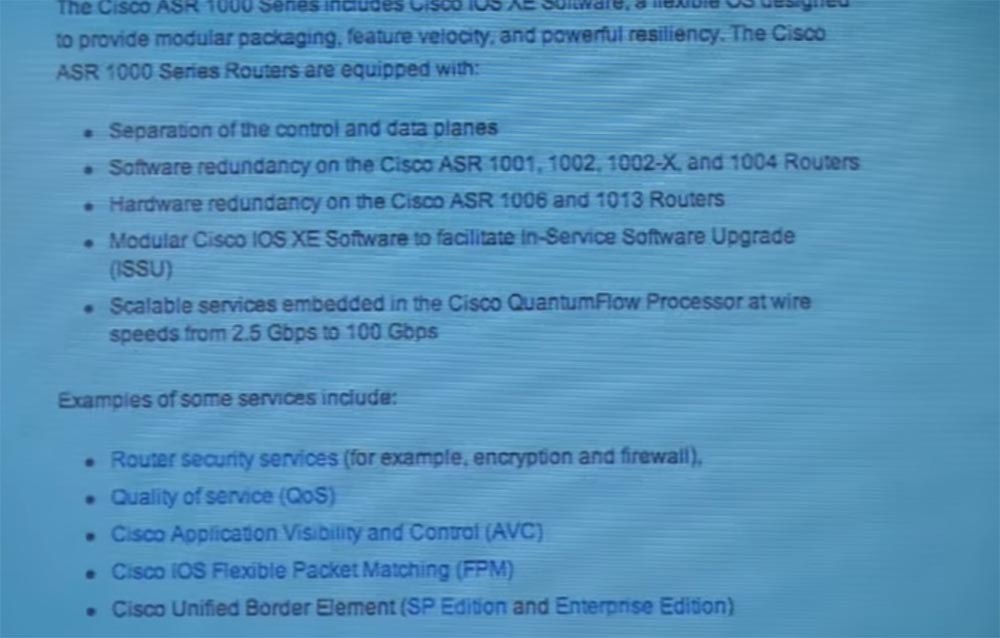
, 2- . 100 - . 2,5 100 320 / , . Cisco, , (control plane), (data plane), QuantumFlow . , , QuantumFlow , . , Cisco . , — 7200, , , . -, , .
. , . Catalist 6500 ? , , , . , GSR (the gigabit switching router), «» -, 7200.

Catalist 6500, 450 , , Catalist 6500 « ». OSR (optical switching router). ASR , 6500, « -». Catalist 6500 .
CRS-3, « ». 100 , , -. , 322 / . . , IP- -, . , 92 , , 18 , CRS-3, 322 / . ASR 9000, « » ASR 1000 96 / . etnerprise- , -.
9000, « ».
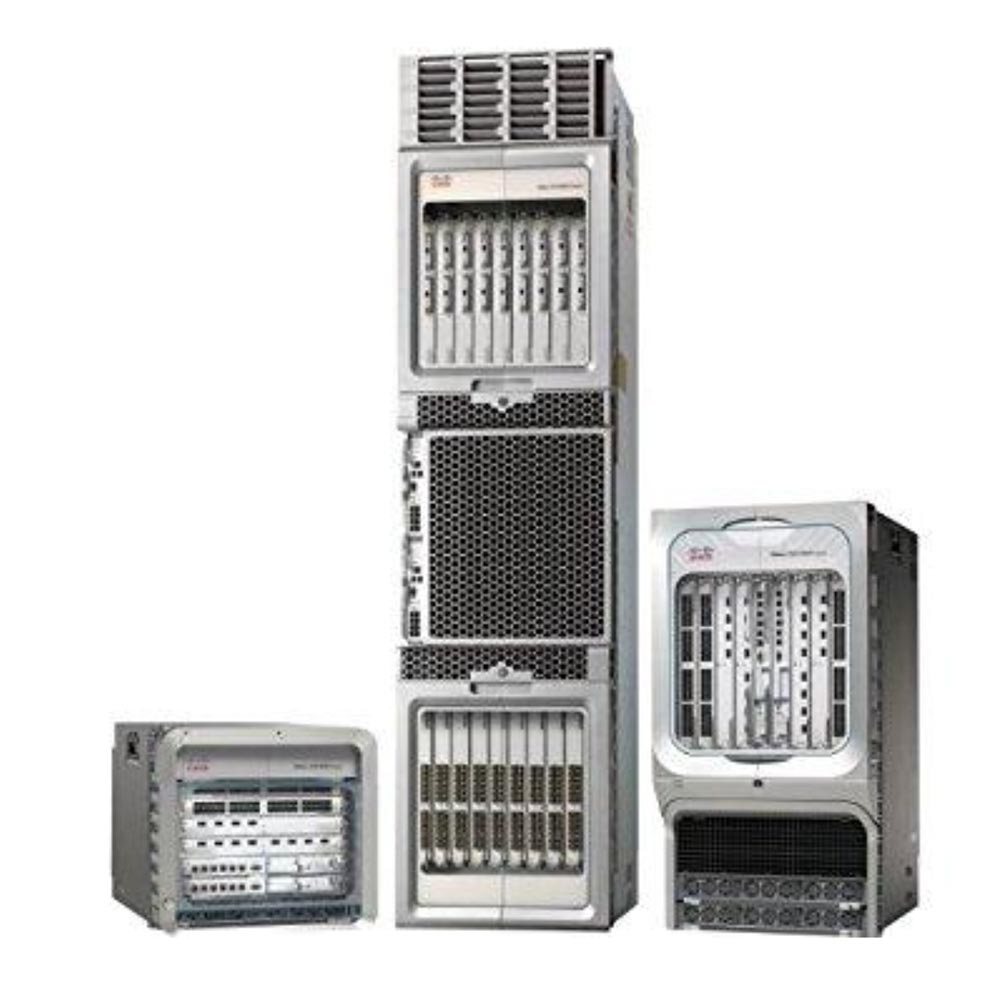
, , MPLS, MPLS. IP. , . Tier . CRS-3. - 9000 . -, , . . enterpise- — . .
, , , , . , - 100 4- . , – , , IP. MPLS, , IT-c - .
– . , . , «» . , . , , , . , . , « » , . , , .. , IT- , . , , ISR G2 , 3 - .
Continued:
FastTrack Training. "Network Basics". "The value of Cisco routers." Eddie Martin December 2012
Thank you for staying with us. Do you like our articles? Want to see more interesting materials? Support us by placing an order or recommending to friends, 30% discount for Habr users on a unique analogue of the entry-level servers that we invented for you: The Truth About VPS (KVM) E5-2650 v4 (6 Cores) 10GB DDR4 240GB SSD 1Gbps $ 20 or how to share the server? (Options are available with RAID1 and RAID10, up to 24 cores and up to 40GB DDR4).
Dell R730xd 2 times cheaper? Only we have 2 x Intel Dodeca-Core Xeon E5-2650v4 128GB DDR4 6x480GB SSD 1Gbps 100 TV from $ 249 in the Netherlands and the USA! Read about How to build an infrastructure building. class c using servers Dell R730xd E5-2650 v4 worth 9000 euros for a penny?

We continue the cycle of 27 articles based on his lectures:
')
01/02: “Understanding the OSI Model” Part 1 / Part 2
03: "Understanding the Cisco Architecture"
04/05: “The Basics of Switching or Switches” Part 1 / Part 2
06: "Switches from Cisco"
07: "Area of use of network switches, the value of Cisco switches"
08/09: "Basics of a Wireless LAN" Part 1 / Part 2
10: "Products in the field of wireless LAN"
11: The Value of Cisco Wireless LANs
12: Routing Basics
13: "The structure of routers, routing platforms from Cisco"
14: The Value of Cisco Routers
15/16: “The Basics of Data Centers” Part 1 / Part 2
17: "Equipment for data centers"
18: "The Value of Cisco in Data Centers"
19/20/21: "The Basics of Telephony" Part 1 / Part 2 / Part 3
22: "Cisco Collaboration Software"
23: The Value of Collaboration Products from Cisco
24: "The Basics of Security"
25: "Cisco Security Software"
26: "The Value of Cisco Security Products"
27: "Understanding Cisco Architectural Games (Review)"
And here is the thirteenth of them.
FastTrack Training. "Network Basics". "The structure of routers, routing platforms from Cisco." Eddie Martin December 2012
Today we will have role-playing games. You will play the role of an IT expert, and I will play the role of a dumb client. So let me tell you about my problem.
I have a headquarters. And I do not understand anything except my business. I made millions of dollars on it, my family has been involved in this business for decades, and so on and so forth. But now I want to expand my business. I have a main office and a small data center in it, but I want to be closer to my customers and I plan to open 5 more new offices within six months, 5 out of a dozen offices, which I am planning to open within 18 months. And if I do not make at least five now - my competitors will eat me.
So, I know that I will have to get everything that is needed to build a WAN. I know that you guys are experts at Cisco and you know everything about networks, you have this little badge that tells me that I have to ask you, what are the requirements for separation?
I spent a lot of countless years and money to provide these people at headquarters with technologies that are very productive, but what technologies should I use in the offices in order to make the staff in the offices as effective as in the head office ? Because I have never done this. I will have 25-30 employees in each of the branches. What are my apps? Yes, whatever, we use a variety of software, computers, tablets.

So what do we need? Did you say: "WAN router accelerator"? Ok, let's draw a router here and sign it with the WAN Accelerator. Then you tell me what this thing is, it sounds cool, but it certainly costs a lot of money!
We must discuss your needs at the beginning. If your employees need to be as efficient as the head office employees, you should be able to use the same applications. Same applications as headquarters. Am I supposed to create a second data center? Of course not. What do we need then? That's right, communication to transfer our applications and information back and forth. What else? Wireless connection? Do you mean access points? Yes, in new offices we need access points, but let's name everything that is needed to create a working network, in one word - WLAN. Next, we need security, otherwise customers will not want to deal with us. I will “hook” to security the necessary services of identification, encryption, and so on.
Let's add another IPS, IP telephony service. In order for an employee to work from home, for example, during a snow storm, when it is impossible to get to work, we need to add a VPN service to the branch office. And, of course, employees will work with the Internet, so we need a firewall.
We will also need equipment for voice communications, that is, telephones. If I have a phone, it means that I have VM functions - voice messages. And I should be able to make an external call, that is, I need to connect to the PSTN public telephone network. We will also need WebEX for video conferencing and the Jabber instant messaging protocol. Let's add here the same video.

Since I am in sales, I’ll also place a server here and add PoE.
Do you know what we just did? We identified the IT resources that should be handled by the router. And, here's another thing we missed - you need to put another switch here, next to the router. Now we have to stuff all these resources into one box so that they work at the same time. And this box is our integrated services router - ISR G2 Router (Integrated Services Router Generation 2). He does everything we just talked about.

Inside it are the most innovative Cisco technology. Inside this box is the motherboard on which the multicore processor is located. It works on the basis of our iOS. In the chips of each ISR, we lay down the VPN and FW (Fire Wall) capabilities, at the hardware level, we also place them on the motherboard. You told the ASA (Adaptive Security Appliance or Adaptive Security Device), yes, this is the same chip as the ASA provides the firewall. Why is this enterprise class device? Because all this is scaled for 200 people. You can buy a big box and put more chips in it. Thus, the largest ASA can handle up to 20 Gbps of traffic and protect it with a firewall. And some large customers need it. This same device, capable of handling 185 Mbps, is ideal for branch offices.

As for WAN acceleration, this is possible thanks to our iOS, which you can install on your device and try it out for 30 days for free, or you can add a separate server to this device, which will provide great opportunities. Now I will show you such a "box", they come in different sizes.

This is a modular design, it has several slots that connect the modules to the motherboard.

A large slot is designed for the server, smaller - for expansion cards. The router can have a larger size, now I will show you a big “box”.

Thus, choosing the appropriate size of the case, you can place everything you need in it and insert everything you want. What needs to be done to enhance the safety effect? Provide our data with IPS, VPN and FW technologies. All this is bought and activated under license. It is all inside at the beginning, and if you need these functions, you buy a license key and turn them on. You activate data encryption via VPN when you use MPLS, start your firewall, use IPS technology. Now you can put your authentication server (AAA server) here if you need a WLAN, along with a WLAN controller. We call this solution ESP — a deployable service platform.
The WLAN controller has a smaller processor on this daughter card and therefore can support up to 10 access points. This is what we call ISM, an integrated service module. And this amount may well be enough for my needs.
Now let's talk about the voice. Inside iOS, there is a CME - Communication Manager Express protocol. Depending on the size of the router, it can become your voice switch and provide support for up to 450 phones or video communication devices, ensure the setting and management of your calls and our recommendation here is to use the TX 200 here. And how can you install and manage it? Inside our iOS there are licenses for this.
A DSP digital signal processor is located on the motherboard. It provides voice communication and voice and video signal processing inside the router, which completely destroys the PSTN (standard telephone network). Thus, inside the router is placed all the necessary "hardware", that's what today is the hardware of our equipment. It is all united by a common motherboard. It is possible to place boards inside the router, which are intended for access to the standard telephone network, for a local network, for connecting to the Internet, placing a fax machine for working with analog phones, a slot for connecting up to 4 analog phones. We can put in the router board for medianet, video transmission support controllers (h.323 at the controller level), PoE, which will provide power through the network and will support energy saving functions (energywise).

This is where the three Cisco architectures converge, this is where the endless field for collaboration is. I will circle the block of cooperation with a green marker. In the data centers, which we will talk about with you today, we use series B, series C and series E routers, which we are talking about now.

What is the difference between all this and the Business Edition 6K? Business Edition 6K is a virtual server that is equipped with all of our communication management systems and other things, and it can support up to 1000 clients. And this is a router. We will talk to you about this tomorrow.
Now let's go to the Cisco site, and I'll show you something else. Here is a page where routers for our branches are shown. These are solutions for remote offices. Here, on this page of the site, it is written: “Transform your branch management experience.”

It has everything you need for building architecture. So, what routers do we use to communicate with the CVO (virtual office)? These are ISR 800 series routers. They are perfect for this task, they have built-in VPN, firewall, everything we need. This series is designed for small home offices. Routers are more serious - these are the 1900, 2900, 3900 series. Consider the 3900 ISR series router.

In this router, we can have more than 72 ports for connections, or if you want these ports to have PoE support — up to 48 ports, which is enough for an office with 35 employees. And it can be a level 3 switch (L3), it is actually a module for the 3560 series switch chassis. There is no supervisor board in this router, it is actually running on the processor on the iOS side, but it has a redundant power supply. It has a service module and 4 slots for interface cards.
A service module is an insertable module equipped with a multi-core processor, a hard disk with a capacity of 1 TB, 48 GB of RAM, connectors to connect to the network, and so on. In essence, this is the server that is placed here. In the E series there is support for VMWare and 4 processors are installed, also 48 GB of RAM and you have the opportunity to run many VM virtual machines to run applications. And this is cool, it gives us perhaps a slight advantage over the decisions of competitors.

In this "box" there are a variety of things, practically everything that I may need. How many competitors offer something similar? If it were not for this solution, I would have to communicate to someone who sells a WLAN, and to another person who sells security and encryption systems, a third person who has equipment for medianet, and so on. You would need 7 different vendors that support these technologies, but when using Cisco equipment, you only apply to 1 seller. We are “number 1” in routing, switches, WLAN, virtual networks, in matters of security, in streaming video transmission, in voice telephony, in all these categories. In some categories, such as PoE, we are the only ones. That is why if you want to get the best-in-class solution - it’s better to contact us.
If you have network problems, one call corrects them all. I came across a situation when I had problems with a telephone connection, and I called one guy, he answered: “These are not my problems”! I called another, he also said that it was not his problems, and so on. And if I didn’t have a meeting with them all, they simply redirected me to each other. And here you only need one call to our support team!
Tell me, who of you knew about this? Only one or two people! So, our routers are unique, they strongly distinguish us from routers from other manufacturers, and any seller in our company should know about it. He should know that we have all 3 architectures concentrated in one box. When we sell our solutions to headquarters, they no longer cease to use it and start ordering solutions already for branches. Thanks to this, we were able to penetrate deeply into the market and occupy our own niche of network equipment. We do not stop in the development of routers, we are engaged in innovations.
I was asked a question, how does our equipment differ from Juniper J-series? Great question! By the fact that they do not transmit or process the voice, they do not. Are you saying they have VoIP? Yes there is. They connect you to a regular PSTN telephone network. Can they create a video bridge? No, they can not! If they have WLAN inside the "box" of the router? No, he's not there. They can make a WLAN, but this is not integrated into their solution at the moment. Can they provide other voice and video features? Can not. They cannot provide phones and customize them. They have neither PoE, nor routers with high density of connection ports (high-density switching). They just make routers, while Cisco makes routers with faster processing. Do they make servers or software for virtual servers? I do not think.
Their routers are probably no better than our 1998 routers when we did OverIP routing at Cisco. I had a neighbor, a very smart guy, he wrote programs, in fact the code for routers, and we worked together at Cisco. One day, at that time I had already quit Cisco, I went out into the yard for a walk and he went out, then I took 2 beers and we went out to talk. He said that they started working on a new project at Cisco, and they want to abandon the first-generation routers that knew all the things we were talking about, since Juniper launched a router with faster packet processing, J1 series, capable of processing 750,000 packets per second, while Cisco routers could provide only 500,000 pps. I said, "Really?" - "Yes, dude, we have problems." I said, "Mickey, let me tell you something." Listen, if I start selling to my customers, network providers, equipment with this stuffing, Cisco just have to cut off my fingers with a very dull knife, one at a time, since I do not deserve this product. Because in Juniper there is no support for all that is in the G1 series, they will never make it better than us in a legitimate way. ” They tried to copy some of our solutions, and put them in their equipment, but they didn’t get out of it. A lot of companies tried. Huawei - God in the IT industry, tried to make a similar copy, but even they could not beat Cisco, because customers know that they are probably not as good as they say in these decisions. And this is our main difference.
Let's continue the conversation about the capabilities of our routers that are important for the client, returning to the Cisco site. Cisco has 3 different groups of routers, we will discuss 2 groups of three. Now we will talk about the different requirements for routers for branches and routers for headquarters. The main office needs a complete solution for processing large amounts of data, and since it is large - we will not put all the possibilities in one device. For branches you need some other equipment. Consider the differences in the characteristics of the ISR G2 family of routers, what they support, what they don't support.

As you can see from this table, routers in this series begin with models 3540 and 3945 V and go down to models of the 1941 and even 800 series that support CVO and are necessary for organizing a virtual office at home, as we discussed with you. Depending on the qualities that we need, they have a different form factor and different possibilities. We ensure the availability of a full-fledged firewall (firewall) for the entire product line, as clients will connect to the Internet. This is built into the hardware of the product, namely the same ASIC integrated circuit used in the ASA. Moreover, we provide hardware accelerated encryption for the entire product line. There is protection from external penetration, filter counters are also available. But all these routers contain different possibilities for voice transmission, video stream support, creating video bridges, the ability to process DSPs to convert traditional telephony into IP telephony, Cisco Unified Communications Manager Express (CME) is essentially a PBX functionality, corporate telephony system. And we can support starting from 450 phones, depending on the device you choose. Untity Extress is voicemail. SIP allows you to establish SIP connections. Digital Voice support makes it possible to install up to 660 PRI T1 connections. FXS and FXO connectivity is available for all platforms. The ISR G2 series offers all of these capabilities in a single solution, allowing the customer to deploy it. In this way, we can ensure the same productivity of the branch staff that headquarters employees possess.
Let's talk about the cost of these devices, about the cost of the technologies incorporated in them. For example, the 2600 series is a multifunctional equipment. We have the first generation of this series ISR G1 2600 and the second generation ISR G2 2900. So, the base cost of the 2691 router, which I chose to buy for my “home lab” without any additional features, is $ 6495. We, as Cisco employees, had discounts on their own. But I was given a modest discount and the price of $ 4,500 only due to the fact that adding a VPN function to this router would cost another $ 1,500. This is really an expensive "box". I bought one, of course, but I had at least two. And the second wife "caught" me. And for a whole year I could not talk about the expensive women's clothing store Talbot in any bad sense.
And when the second generation of these routers arrived, it was replaced by the first one, which provided 4 times higher packet processing capacity, ISR G2 2900 router, with all the necessary lotions and built-in functions (VPN, firewall, etc.) buy them separately for $ 1500 each), do you know how much it cost? Only $ 3895, that is twice cheaper! And now, when this generation of routers is leaving, and the new provides 2-3 times more features, they cost the same money. I have already told you about this trend. The more technology inside, the cheaper they cost the client. What happens to the prices of our products? They are constantly decreasing as demand grows and technologies develop. And that is why I consider renting such equipment as more profitable for our clients.
I note that 80% of our clients work not in headquarters, but in branches. . ISR G2, .

. , , , ISR G2. , HWIC CDMA, VDSL , , SRE — Service Rating Engine , . , 72 FXS , . . , Walmart? ISR G2, , , .
, ASR, Aggregation Services Routers, , , , -. -, -, . . ASR 1000. 6 .

- SDN, , , . - .
Cisco ASR . . QuantumFlow Processor. , , ASR 1000. Cisco , . 40 , ASR . ASR 1000, 5000, 9000 – QuantumFlow. 40 , 4 , 160 . Cisco 5 , (R&D), -, .

, 2- . 100 - . 2,5 100 320 / , . Cisco, , (control plane), (data plane), QuantumFlow . , , QuantumFlow , . , Cisco . , — 7200, , , . -, , .
. , . Catalist 6500 ? , , , . , GSR (the gigabit switching router), «» -, 7200.

Catalist 6500, 450 , , Catalist 6500 « ». OSR (optical switching router). ASR , 6500, « -». Catalist 6500 .
CRS-3, « ». 100 , , -. , 322 / . . , IP- -, . , 92 , , 18 , CRS-3, 322 / . ASR 9000, « » ASR 1000 96 / . etnerprise- , -.
9000, « ».

, , MPLS, MPLS. IP. , . Tier . CRS-3. - 9000 . -, , . . enterpise- — . .
, , , , . , - 100 4- . , – , , IP. MPLS, , IT-c - .
– . , . , «» . , . , , , . , . , « » , . , , .. , IT- , . , , ISR G2 , 3 - .
Continued:
FastTrack Training. "Network Basics". "The value of Cisco routers." Eddie Martin December 2012
Thank you for staying with us. Do you like our articles? Want to see more interesting materials? Support us by placing an order or recommending to friends, 30% discount for Habr users on a unique analogue of the entry-level servers that we invented for you: The Truth About VPS (KVM) E5-2650 v4 (6 Cores) 10GB DDR4 240GB SSD 1Gbps $ 20 or how to share the server? (Options are available with RAID1 and RAID10, up to 24 cores and up to 40GB DDR4).
Dell R730xd 2 times cheaper? Only we have 2 x Intel Dodeca-Core Xeon E5-2650v4 128GB DDR4 6x480GB SSD 1Gbps 100 TV from $ 249 in the Netherlands and the USA! Read about How to build an infrastructure building. class c using servers Dell R730xd E5-2650 v4 worth 9000 euros for a penny?
Source: https://habr.com/ru/post/350752/
All Articles